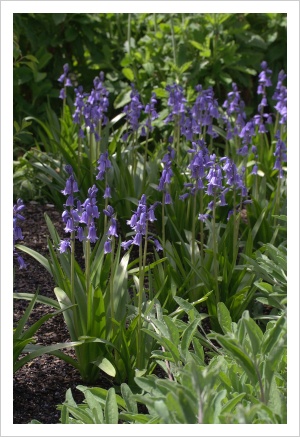Bluebells
My younger brother has ten acres of ancient woodland on his farm in Nottinghamshire. This wood is at least four hundred years old and may be much older. Like many such woodland it is carpeted by hundreds of thousands of bluebells during spring. As a boy in the 1950s I was besotted by a nearby bluebell wood. The stillness, the quiet of this special place was only broken by bird song and the ratatatat of a pair of great spotted woodpeckers drilling a nesting hole in one of the old trees.
 The English bluebell can be readily distinguished from the Spanish species by its smaller size, narrower leaves, one sided nodding inflorescence and a fragrance which is lacking in H. hispanica.
The English bluebell can be readily distinguished from the Spanish species by its smaller size, narrower leaves, one sided nodding inflorescence and a fragrance which is lacking in H. hispanica.
I do grow H. non-scripta in the garden but it is nowhere near as telling as some of the selected Spanish bluebell clones such as the 40cm tall ‘Excelsior’ which carries thirty or more large bells, each with a pronounced flare at the base of every lobe. The mauve blue flowers, with a deeper blue stripe down each lobe, are held elegantly and symmetrically around a strong stem.
I have two amethyst pink varieties ‘Queen of the Pinks’ and ‘Dainty Maiden’ The former is slightly more robust than the latter but otherwise it’s hard to tell any difference between them. Both are very beautiful with large flared bells on 35 cm tall stems.
There’s a large planting of the H. hispanica ‘White City’ under an old Japanese maple in a garden near the house. This variety is beautiful in both leaf and flower. The white bells are so clean and the green leaves are so fresh. When it’s in flower I sit on the veranda and melt with the wonder of it all.